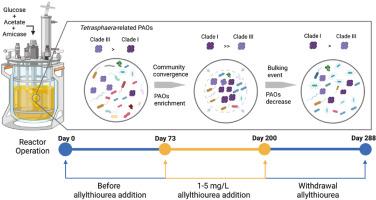当前位置:
X-MOL 学术
›
Environ. Res.
›
论文详情
Our official English website, www.x-mol.net, welcomes your
feedback! (Note: you will need to create a separate account there.)
Microbiome assembly mechanism and functional potential in enhanced biological phosphorus removal system enriched with Tetrasphaera-related polyphosphate accumulating organisms
Environmental Research ( IF 7.7 ) Pub Date : 2023-06-23 , DOI: 10.1016/j.envres.2023.116494 Hui Wang 1 , Limin Lin 2 , Lu Zhang 2 , Ping Han 3 , Feng Ju 4
Environmental Research ( IF 7.7 ) Pub Date : 2023-06-23 , DOI: 10.1016/j.envres.2023.116494 Hui Wang 1 , Limin Lin 2 , Lu Zhang 2 , Ping Han 3 , Feng Ju 4
Affiliation

|
Tetrasphaera-related polyphosphate accumulating organisms (PAOs) are the key functional guilds for enhanced biological phosphorus removal (EBPR) systems. Their biomass enrichment can be enhanced by the nitrification inhibitor allylthiourea (ATU). However, the underlying assembly mechanism and the functional potential of the EBPR microbiome regulated by ATU are unclear. This study investigates the effect of ATU on microbiome assembly and functional potential by closely following the microbiota dynamics in an EBPR system enriched with Tetrasphaera -related PAOs for 288-days before, during and after ATU addition. The results showed that ATU addition increased microbiota structural similarity and compositional convergence, and enhanced determinism in the assembly of EBPR microbiome. During exposure to ATU, Tetrasphaera -related PAOs were governed by homogeneous selection and the dominant species revealed by 16S rRNA gene-based phylogenetic analysis shifted from clade III to clade I. Meanwhile, ATU supply promoted significant enrichment of functional genes involved in phosphate transport (pit ) and polyphosphate synthesis and degradation (ppk1 and ppk2 ), whereas both Nitrosomonas and ammonia monooxygenase-encoding genes (amoA/B/C ) assignable to this group of nitrifying bacteria decreased. Moreover, ATU addition relieved the significant abundance correlation between filamentous bacteria Ca. Promineofilum and denitrifying Brevundimonas (FDR-adjusted P < 0.01), damaging their potential synergic or cooperative interactions, thus weakening their competitiveness against Tetrasphaera -related PAOs. Notably, ATU withdrawn created opportunistic conditions for the unexpected explosive growth and predominance of Thiothrix filaments, leading to a serious bulking event. Our study provides new insights into the microbial ecology of Tetrasphaera -related PAOs in EBPR system, which could guide the establishment of an efficient microbiota for EBPR.
中文翻译:

富含 Tetrasphaera 相关多磷酸盐积累生物的增强生物除磷系统中的微生物组组装机制和功能潜力
Tetrasphaera 相关多磷酸盐积累生物 (PAO) 是增强生物除磷 (EBPR) 系统的关键功能组合。它们的生物量富集可以通过硝化抑制剂烯丙基硫脲 (ATU) 来增强。然而,受 ATU 调节的 EBPR 微生物组的潜在组装机制和功能潜力尚不清楚。本研究通过在添加 ATU 之前、期间和之后 288 天密切跟踪富含 Tetrasphaera 相关 PAO 的 EBPR 系统中的微生物群动力学,调查了 ATU 对微生物组组装和功能潜力的影响。结果表明,ATU 添加增加了微生物群结构相似性和组成收敛性,并增强了 EBPR 微生物组组装的确定性。在暴露于 ATU 期间,Tetrasphaera 相关的 PAOs 受同质选择控制,基于 16S rRNA 基因的系统发育分析揭示的优势物种从进化枝 III 转移到进化枝 I。同时,ATU 供应促进了参与磷酸盐转运 (pit) 和多磷酸盐合成和降解 (ppk1 和 ppk2) 的功能基因的显著富集,而可分配给这组硝化细菌的亚硝化单胞菌和氨单加氧酶编码基因 (amoA/B/C) 均减少。此外,ATU 添加减轻了丝状细菌 Ca. promineofilum 和反硝化短短胞菌之间的显著丰度相关性 (FDR 调整 P < 0.01),破坏了它们潜在的协同或合作相互作用,从而削弱了它们对 Tetrasphaera 相关 PAO 的竞争力。值得注意的是,ATU 的撤回为 Thiothrix 细丝的意外爆炸性生长和优势创造了机会条件,导致严重的膨胀事件。 我们的研究为 EBPR 系统中 Tetrasphaera 相关 PAOs 的微生物生态学提供了新的见解,可以指导建立有效的 EBPR 微生物群。
更新日期:2023-06-23
中文翻译:

富含 Tetrasphaera 相关多磷酸盐积累生物的增强生物除磷系统中的微生物组组装机制和功能潜力
Tetrasphaera 相关多磷酸盐积累生物 (PAO) 是增强生物除磷 (EBPR) 系统的关键功能组合。它们的生物量富集可以通过硝化抑制剂烯丙基硫脲 (ATU) 来增强。然而,受 ATU 调节的 EBPR 微生物组的潜在组装机制和功能潜力尚不清楚。本研究通过在添加 ATU 之前、期间和之后 288 天密切跟踪富含 Tetrasphaera 相关 PAO 的 EBPR 系统中的微生物群动力学,调查了 ATU 对微生物组组装和功能潜力的影响。结果表明,ATU 添加增加了微生物群结构相似性和组成收敛性,并增强了 EBPR 微生物组组装的确定性。在暴露于 ATU 期间,Tetrasphaera 相关的 PAOs 受同质选择控制,基于 16S rRNA 基因的系统发育分析揭示的优势物种从进化枝 III 转移到进化枝 I。同时,ATU 供应促进了参与磷酸盐转运 (pit) 和多磷酸盐合成和降解 (ppk1 和 ppk2) 的功能基因的显著富集,而可分配给这组硝化细菌的亚硝化单胞菌和氨单加氧酶编码基因 (amoA/B/C) 均减少。此外,ATU 添加减轻了丝状细菌 Ca. promineofilum 和反硝化短短胞菌之间的显著丰度相关性 (FDR 调整 P < 0.01),破坏了它们潜在的协同或合作相互作用,从而削弱了它们对 Tetrasphaera 相关 PAO 的竞争力。值得注意的是,ATU 的撤回为 Thiothrix 细丝的意外爆炸性生长和优势创造了机会条件,导致严重的膨胀事件。 我们的研究为 EBPR 系统中 Tetrasphaera 相关 PAOs 的微生物生态学提供了新的见解,可以指导建立有效的 EBPR 微生物群。































 京公网安备 11010802027423号
京公网安备 11010802027423号